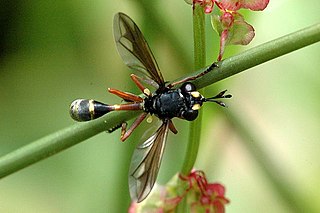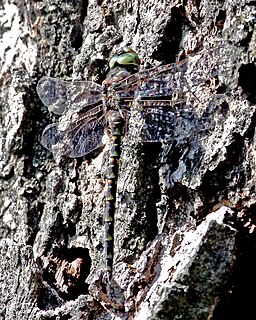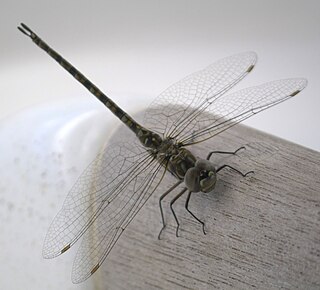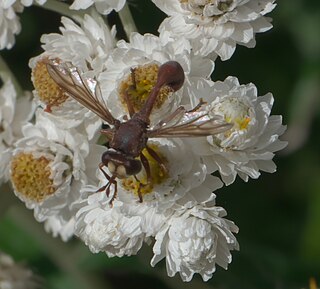
The Conopidae, usually known as the thick-headed flies, are a family of flies within the Brachycera suborder of Diptera, and the sole member of the superfamily Conopoidea. Flies of the family Conopidae are distributed worldwide in all the biogeographic realms except for the poles and many of the Pacific islands. About 800 species in 47 genera are described worldwide, about 70 of which are found in North America. The majority of conopids are black and yellow, or black and white, and often strikingly resemble wasps, bees, or flies of the family Syrphidae, themselves notable bee mimics. A conopid is most frequently found at flowers, feeding on nectar with its proboscis, which is often long.
In the geologic timescale, the Valanginian is an age or stage of the Early or Lower Cretaceous. It spans between 139.8 ± 3.0 Ma and 132.9 ± 2.0 Ma. The Valanginian stage succeeds the Berriasian stage of the Lower Cretaceous and precedes the Hauterivian stage of the Lower Cretaceous.

Lineodes is a genus of snout moths of the subfamily Spilomelinae in the family Crambidae. The genus was described by Achille Guenée in 1854, with Lineodes hieroglyphalis as the type species.

Physocephala is a genus of flies from the family Conopidae.

Physocephala nigra is a species of fly from the genus Physocephala in the family Conopidae. Their larvae are endoparasites of bumble bees of the genus Bombus.

Gomphaeschna furcillata is a dragonfly in the genus Gomphaeschna, in the family Aeshnidae. A common name for Gomphaeschna furcillata is "harlequin darner". Gomphaeschna furcillata is found in North America. It is native to Canada and the Continental US.
Pachygnatha furcillata is a species of long-jawed orb weaver in the spider family Tetragnathidae. It is found in the United States.
Gozmanyina majestus is a species of cosmochthoniid in the family Cosmochthoniidae.
Phloeosinus pini is a species of crenulate bark beetle in the family Curculionidae. It is found in North America.

Physocephala sagittaria is a species of thick-headed fly in the family Conopidae.
Physocephala marginata is a species of thick-headed fly in the family Conopidae.

Physocephala tibialis is a species of thick-headed fly found throughout the eastern United States, often near flowering plants. The adult fly is primarily black with a yellow face and thin white stripes on the abdomen. It is commonly found along the east coast of the United States and is often found near flowering plants.
Physocephala texana is a species of thick-headed fly in the family Conopidae.
Physocephala floridana is a species of thick-headed fly in the family Conopidae.

Gomphaeschna is a genus of pygmy darners in the dragonfly family Aeshnidae. There are about nine described species in Gomphaeschna.

Physocephala burgessi is a species of thick-headed fly in the family Conopidae.
Sabatieria furcillata is a nematode in the family Comesomatidae ranking. It was described in 1954 by the Austrian zoologist Wolfgang Wieser.

Venatrix furcillata, one of the wolf spiders, is a mid sized spider found in eastern Australia. The body length of the female is up to 13 mm, the male 9 mm. The abdomen has distinctive tapering markings. Sometimes noted in suburban gardens and lawns. It lives in a simple burrow, but may be seen migrating in large numbers to a communal web, an unusual feature for wolf spiders. The grey coloured spherical egg sac is around 6 mm in diameter, carried by the female. Eggs are 45 to 60 in number, 0.8 mm in diameter. Prey is ground dwelling insects. The spider has been identified as occurring in Queensland, New South Wales, and Victoria.










